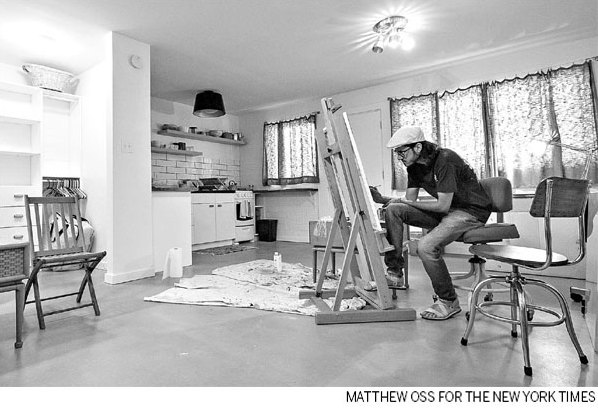Out of Baghdad, he can exhale and paint
Updated: 2013-09-08 07:40
By Fernanda Santos(The New York Times)
|
|||||||
PHOENIX, Arizona - First, the men cursed him, loyalists of Iraq's Mahdi Army militia furious at the slender barber who dared to sketch pictures of nude women. Then, they spat on him, blindfolded him and punched him as they took him through a busy market in Baghdad, where someone grabbed a pair of scissors and cut his long hair.
The abuse did not end there for the barber, Bassim al-Shaker, who was beaten so badly that he was hospitalized. But he is much more than a barber. In June, he was in Italy, his oil paintings gracing the Iraq Pavilion at the 55th Venice Biennale. In July, he arrived here in the American West, one of six foreign artists chosen to share their knowledge and create work.
For Mr. Shaker, 28, the experience is as much about liberation as it is about escape.
In Baghdad, he feared for his life, as the men who tortured him got out of prison this year and vowed to seek revenge, thinking it was because of him that they had wound up behind bars.

Mr. Shaker's journey from Iraq to Arizona began one morning in Baghdad, when he found himself racing through an alley, jumping across rooftops and climbing over fences to escape his pursuers, finding temporary harbor in a house behind an Iraqi Army blockade. Artists came to his rescue.
He left his home country for a city that is home to one of the largest Iraqi communities in the United States - most of them refugees to whom this is a first stop, the rest transplants who chose to move here. Mr. Shaker came as neither. He is an artist on a business visa, fueled by the freedom to put on canvas "whatever is in my heart," he said.
Much of it is colored by a lifetime of wars, repression and sanctions. For now, though, he takes the train to the Arizona State University Art Museum, the international artists' host in neighboring Tempe, where he has been working on a portrait of a wrinkled man wearing a kaffiyeh, the traditional headdress of men in Iraq. He is using black and white oil paints "because life in Iraq is black and white," lacking the joy that, to him, bright colors would represent.
On a recent morning, Mr. Shaker said he had just returned to Baghdad from Beirut this spring when three men began chasing him. The drawings that got him in trouble were sketches of the Venus de Milo, practice for the entrance exam at Baghdad University's College of Fine Arts. He kept them on a notepad in the barbershop, where the militiamen found them when they stopped by for haircuts.
In Beirut, Mr. Shaker was one of eight artists attending a series of workshops sponsored by Sada (Echo) for Contemporary Iraqi Art, a nonprofit that fosters art in a country whose arts scene has been choked by religious fundamentalism and years of unrest.
Once he was back in Baghdad, his pursuers forced him into hiding in the house behind the army blockade where he stayed in a small room for a month, confined to a small second-floor room, "eating and sleeping," he said, "like a prison."
Concerned about Mr. Shaker's safety, Sada's founding director, Rijin Sahakian, an Iraqi expatriate, contacted Gordon Knox, director of the university art museum. She knew Mr. Knox had started a residency program for foreign artists in Phoenix and wondered if Mr. Shaker could join.
"He's obviously very talented," Ms. Sahakian said from Beirut, "but we were also focused on saving his life."
Mr. Shaker is unique among the artists in the residency program because of his circumstances. Other residents have come from places like Portugal, England, Denmark and Mexico.
Mr. Shaker's visa expires at the end of the year. Once he goes back, he will move to a different neighborhood, he said, hoping that a new address will be enough to keep him safe.
The New York Times
|
A painting by Bassim al-Shaker, top, who feared for his life in Iraq. Mr. Shaker has been working on his art in Arizona. Arizona State University Art Museum |
(China Daily 09/08/2013 page12)
